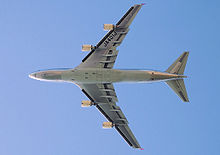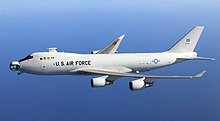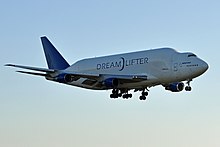Boeing 747-400
The "Advanced Series 300" was announced at the September 1984 Farnborough Airshow, targeting a 10% cost reduction with more efficient engines and 1,000 nautical miles [nmi] (1,900 km; 1,200 mi) of additional range.[7] By early 1984, company officials had identified five development objectives for the latest 747 upgrade: new technologies, an enhanced interior, a 1,000 nautical miles (1,900 km; 1,200 mi) range increase, more efficient engines, and a 10 percent reduction in operating cost.[9] Seven early customers, namely British Airways, Cathay Pacific, KLM, Lufthansa, Northwest, Qantas and Singapore Airlines, formed a consultative group to advise Boeing on the 747-400's design process.[10] While the aircraft was planned as a new-technology upgrade, Boeing originally proposed minimal design changes in order to reduce development cost and retain commonality with existing models.[13] More than fifty percent of the aircraft was produced by subcontractors, with major structures, engine nacelles, and sub-assemblies supplied by Northrop, and upper deck fuselage frames from Daewoo.As the flight test program proceeded, Boeing encountered problems in the 747-400's production process, leading it to disclose delivery delays of up to one month for the first 20 aircraft built.[13] A primary reason for the delays was the unprecedented complexity of interior configurations offered to airlines, which ranged from lavatory and galley locations to the color shades of cabin warning labels.[13] Coupled with new, relatively inexperienced workers, a lack of veteran technicians, interior configurations needing costly re-work, and teething problems with electronics integration on the advanced flight deck, 747-400 production fell behind schedule.[13] The company managed to resolve early production issues by mid-1989, with the first example airframes of all three engine variants delivered within four months of each other, and overall delays not exceeding several weeks.[18] In May 1989, one week before the initial delivery to the 747-400's first European customer, KLM, the Joint Aviation Authorities (JAA) shocked Boeing by refusing to grant regulatory certification for the aircraft, citing the upper deck cabin floor's resistance to collapse in the event of a sudden decompression.[19] In the days leading up to the first delivery to KLM, negotiations between Boeing, the FAA, and the JAA resulted in a compromise: a temporary operating certificate would be issued for the 747-400, provided that the manufacturer develop a structural retrofit for the aircraft within two years.Qantas initially used the 747-400ER for the Melbourne to Los Angeles and Dallas to Sydney route allowing the completion of the flight with full passenger load and cargo.[20] In the 2000s, as part of an effort to promote sustainable and alternative fuel development, as well as lower emissions, several 747-400 operators studied the use of oil extracted from the jatropha plant.The change in emphasis from hub and spoke operations to point-to-point flights has also reduced the need for jumbo jets (very large aircraft (VLA) with more than 400 seats) like the 747 and Airbus A380.[citation needed] Since the cost of replacing a 747-400 is high (an airline must purchase or lease another wide-body), some operators choose to fly the 747-400 to the conclusion of its accepted useful life and then scrap it.[35] In March 2024, Asiana Airlines announced to retire their sole remaining 747-400, leaving Air China as the last scheduled passenger operator in Asia.[37] The 747-400's glass cockpit features CRT displays which show flight instrumentation along with engine indication and crew alerting system (EICAS) diagnostics.[10] The flight engineer station on the previous 747s is no longer installed, and the new displays and simplified layout results in a two-thirds reduction of switches, lights, and gauges versus the Classic 747.[10] The redesigned 747-400 interior features new cabin sidewalls, heat-resistant phenolic glass and carbon composite paneling, and larger storage bins.[15] The aircraft had a takeoff weight of 892,450 pounds (404,810 kg), and in order to satisfy Fédération Aéronautique Internationale regulations, climbed to a height of 6,562 feet (2,000 m).[15] On February 9, 2020, a British Airways Boeing 747-400 broke the New York–London subsonic airliner speed record in 4 hours 56 minutes, pushed by the powerful Jetstream linked to Storm Ciara.While using the updated systems and wing design of the passenger versions, it features the original short upper deck found on the classic 747s to reduce weight.A locked partition separates the cargo area from the forward passenger cabin, and the -400M also features additional fire protection, a strengthened main deck floor, a roller-conveyor system, and passenger-to-cargo conversion equipment.Qantas was the only customer for the passenger version of the 747-400ER, chosen by the airline to allow for full loads between Melbourne and Los Angeles, particularly in the western direction.Used passenger 747-400 aircraft have been converted into an outsize, "Large Cargo Freighter" (LCF) configuration to ferry sub-assemblies to Everett, Washington for final assembly.[57] The conversion, designed by Boeing engineers from Puget Sound, Moscow and Canoga Park, Cal., and Gamesa Aeronáutica in Spain,[58] was carried out in Taiwan by a subsidiary of the Evergreen Group.[69][failed verification][needs update] The first hull loss of a 747-400 occurred on November 4, 1993, when China Airlines Flight 605, flying from Taipei to Hong Kong's Kai Tak Airport, touched down more than 2,100 feet (640 m) past the runway's displaced threshold during 20-knot (gusting to 38 knots) crosswinds.[76] On November 7, 2018, Sky Lease Cargo Flight 4854, a 747-400F overrun the runway on landing at Halifax Stanfield International Airport in Nova Scotia, Canada, and broken into two pieces, causing 3 of 4 people onboard injured with no fatalities.[80][81] On January 31, 2001, the pilot of Japan Airlines Flight 907, a 747-400D bound for Naha International Airport from Tokyo Haneda Airport, made an emergency dive to avoid a collision with a Japan Airlines DC-10-40 due to conflicting instructions from air traffic control; several people on the 747-400 suffered injuries during the evasive manoeuvres and some interior damage was sustained to the aircraft.[89] Following the gradual withdrawal of older examples of the type from passenger service from the early-2010s onward, a relatively large number of Boeing 747-400s have entered preservation after being decommissioned.


















B744 roadLufthansaWide-body airlinerManufacturerBoeingAtlas AirUPS AirlinesNorthwest AirlinesBoeing 747-300Boeing YAL-1747 SupertankerBoeing DreamlifterBoeing 747-8Boeing Commercial AirplanesBoeing 747Farnborough Airshownautical milesmaiden flightType certificationairframewingletsPratt & Whitney PW4000General Electric CF6Rolls-Royce RB211glass cockpitflight engineermaximum takeoff weighttransports of heads of stateengine testbedSpirit of MojaveDreamlifterDreamlinerMcDonnell Douglas MD-11Airbus A340Boeing 777Airbus A350Cathay PacificSingapore AirlinesBritish AirwaysUnited AirlinesAir FranceMalaysia AirlinesJapan Airlinescommonalitycathode-ray tubewingletaerodynamic dragPratt & Whitney PW4056General Electric CF6-80C2B1FRolls-Royce RB211-524G/Hauxiliary power unitPratt & Whitney CanadaN661USEverett factoryNorthropDaewoo737-400Renton factoryBoeing FieldPaine FieldFederal Aviation Administrationlavatorygalleywarning labelsNorthwest Flight 85Joint Aviation Authoritiessudden decompressionexplosive devicesoperating certificateCargoluxQantasMelbourneLos AngelesDallasliquid-crystal displaysjatrophaAir New Zealandjatropha oilContinental AirlinesPhilippine Airlines777-300ERChina AirlinesBoeing 787 DreamlinerAirbus A350 XWBAirbus A380Narita International AirportSeattle-Tacoma International AirportAirbus A330Virgin AtlanticCOVID-19 pandemicAir IndiaDirectorate General of Civil AviationAsiana AirlinesAir Chinaleading edgeHoneywelleconomy classbusiness classDelta Air LinesVH-OJAflew non-stopLondon HeathrowSydneyFédération Aéronautique InternationaleJetstreamStorm CiaraKorean AirNippon Cargo Airlinesairborne laserAir France-KLMAir Atlanta IcelandicAll Nippon AirwaysPokémonMarshall AerospaceBoeing 777-200LRBoeing P-8A Poseidonpotable waterAir Bridge CargoNational Airlines Flight 102SIA Engineering CompanyCathay Pacific CargoIsrael Aerospace IndustriesEVA Airmarine shippingEverett, WashingtonAero Spacelines Super Guppy
